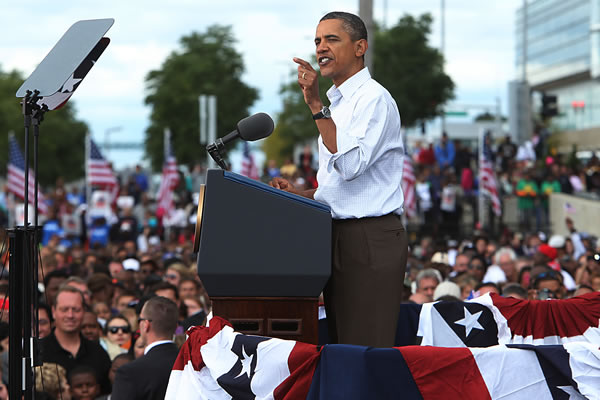Morning Bell: Big Government Rising?
Mike Brownfield /
How does a trillion dollars in more federal government spending sound to you? For most Americans, the idea of growing government at a time when deficits are sky high might seem preposterous. But for many on the left, it’s the only way they can think of to get the economy moving again, and they think some sort of new New Deal should be included in President Obama’s much-touted jobs speech on Thursday. Their end goal? The continued rise of big government.
Case in point: Congresswoman Maxine Waters (D-CA). On Sunday’s Meet the Press, she unveiled her prescription for pulling the U.S. economy out of its slump, and it carries an incredibly high price tag. “I’m talking about a jobs program of a trillion dollars or more,” she said. “We’ve got to put Americans to work. That’s the only way to revitalize this economy.”
Now one might write off Waters’ call for a trillion in additional spending as hyperbole (after all, she had some choice words for the Tea Party last month), but the amped-up rhetoric demanding bigger government is becoming pervasive on the left, despite a seemingly endless stalemate this summer over the debt ceiling, whether the government should borrow even more money, and what spending could be cut. Now, though, it’s clear that liberals are ready to keep up the fight for big government, whether it’s Teamsters president James P. Hoffa calling for a war on the Tea Party or Vice President Joe Biden applauding the AFL-CIO for keeping the “barbarians from the gates” — that is, their political opponents.
It’s no surprise that the left favors more government spending–after all, it’s the core of their philosophy. Yet for months we have heard President Obama give lip service to cuts in spending, largely in response to the political shift that conservatives and the Tea Party revolution ushered into Washington last November. But with the President’s jobs speech on Thursday, Americans may see Obama “go bold” and propose a return to big government.
In his speech to labor unions in Detroit yesterday, President Obama gave a preview of what “bold” means to him: more infrastructure spending. The trouble is that the President tried this approach before in his stimulus plan, and it just didn’t work. The stimulus included $48.1 billion for transportation infrastructure, but the funded projects have been very slow to get underway and have had a minuscule impact on economic activity.
An “infrastructure bank” is the latest permutation of the President’s plan for more of the same kind of spending. In the President’s February 2011 highway reauthorization proposal, the infrastructure bank would be funded by an appropriation of $5 billion per year in each of the next six years and would provide loans, loan guarantees, and grants to eligible transportation infrastructure projects. Translation: more big government spending and more federal bureaucracy. As Heritage’s Ronald Utt explains, that’s a road to nowhere.
The President’s ongoing obsession with an infrastructure bank as a source of salvation from the economic crisis at hand is—to be polite about it—a dangerous distraction and a waste of his time . . . Obama’s infrastructure bank would likely yield only modest amounts of infrastructure spending by the end of 2017 while having no measurable impact on job growth or economic activity—a prospect woefully at odds with the economic challenges confronting the nation.
But that’s not the only way the President is planning on increasing spending while growing the reach of the federal government. Another of his ideas? New federal funding for school construction, a job that has historically fallen under the direction of state and local governments. Heritage’s Lindsey Burke explains why the idea is problematic:
Practically speaking, the federal government is the most inefficient mechanism for financing school construction. If Washington funds school construction, it must pay prevailing wages, which increase costs, on average, by 22 percent. Because of Davis–Bacon labor laws, schools that receive federal funding for school construction would typically have to hire union workers, increasing costs and preventing non-union construction companies from having a seat at the bidding table.
Both the infrastructure bank and the President’s plan for funding schools have common denominators: increased spending and the expansion of government. But he’s tried that before–in tandem with new regulations–with the only result being more deficit spending, businesses sitting on the sidelines waiting for certainty from the government, and an economy that produced no new jobs in August. And now, as 14 million unemployed Americans wait for the hope and change they were promised, they’re getting more of the same from their President and politicians on the left: a movement toward bigger government that will only make matters worse.
Quick Hits:
- More than 60 percent of Americans say they disapprove of how President Obama is handling the economy and the jobs situation, according to a new Washington Post-ABC News poll.
- European stocks plunged on Monday as investors reacted to fears over Europe’s sovereign debt crisis and economic growth in both Europe and the United States.
- The Senate Banking Committee will hold a confirmation hearing today for Richard Cordray, President Obama’s choice to be the first director of the Consumer Financial Protection Bureau.
- Turkey has suspended all trade and military ties with Israel a day after it ordered all senior Israeli diplomats to leave the country by Wednesday.
- Listen to our interview with the mother of three from Montana who posed as a terrorist in jihadist chat rooms to help law enforcement hunt enemies of America.

